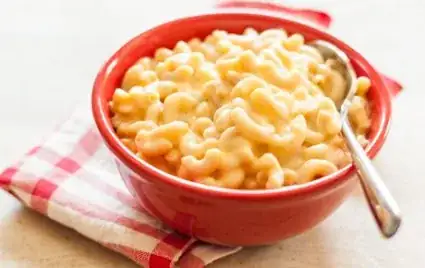Based on your description, it looks like you've made the common error of assuming that equal volume is equal weight.
Butter is more dense than flour so the same volume does not equal the same weight... you must convert the 1/4 cup for each product using a trustworthy site.
Here's one that looks OK and includes both butter and flour.
As you can see, 1/4 cup of butter is 57 grams. If you look at the next chart, you see the conversion for flour and you can see that 1/4 cup of flour is only 32 grams!
This means that, if you added 60 grams of each, you've got twice as much flour (the thickening agent) than the recipe calls for... so of course it's going to be way too thick.
I recommend you start over and be more careful with your conversions.
As a note, my standard recipe for Mac and Cheese uses 4 tbsp each of flour and butter (generally equivalent to 1/4 cup) while it only calls for two cups of milk rather than three, so I usually have a much thicker white sauce than yours will be and I find it quite enjoyable.
The Joy of Cooking (an iconic American cookbook) recipe calls for the same percentages for their white sauce - 2:2 tbsp of butter/flour with 1 cup of milk.
To answer your questions in the comments, pure butter (rather than spreadable butter/margarine or butter blends) in the US is usually sold in one pound boxes containing four sticks per box. Each stick is 1/4 pound of butter which is equivalent to 1/2 cup. Each stick is wrapped in waxed paper and has tick marks to show each tablespoon of butter for a total of eight tablespoons.

Occasionally the paper isn't perfectly aligned but it's usually a simple matter to adjust your cut position to allow for the offset.
So, a cup of butter is two sticks, a 1/4 cup of butter is a half stick. and a tablespoon is 1/8th of a stick.
Your second question I think comes from a misunderstanding of how thick the white sauce is when completed correctly. With the proper percentages of flour and butter (and using two cups of milk), the final consistency you get is somewhere between thick cream-based soup and thin hummus. Adding the cheese usually doesn't effect the thickness because the cheese melts and is about the same consistency as the white sauce. I also like adding softer cheeses that melt well like goat cheese for both flavor and textural reasons.
Once baked, the final outcome will be fairly solid and casserole-like. You should be able to cut it with a knife and expect it to hold its shape to a good degree, like this:

This recipe will not make the creamy-style macaroni and cheese (an example is shown below. That is a different process and is generally not baked.

So that you can see the differences in the recipes of baked and creamy styles I'll link you to a couple "creamy-style" mac and cheese recipes from other sources. This is a simple example recipe from Whole Foods Market, an American grocery chain and here's a slightly more complicated recipe from Serious Eats.


